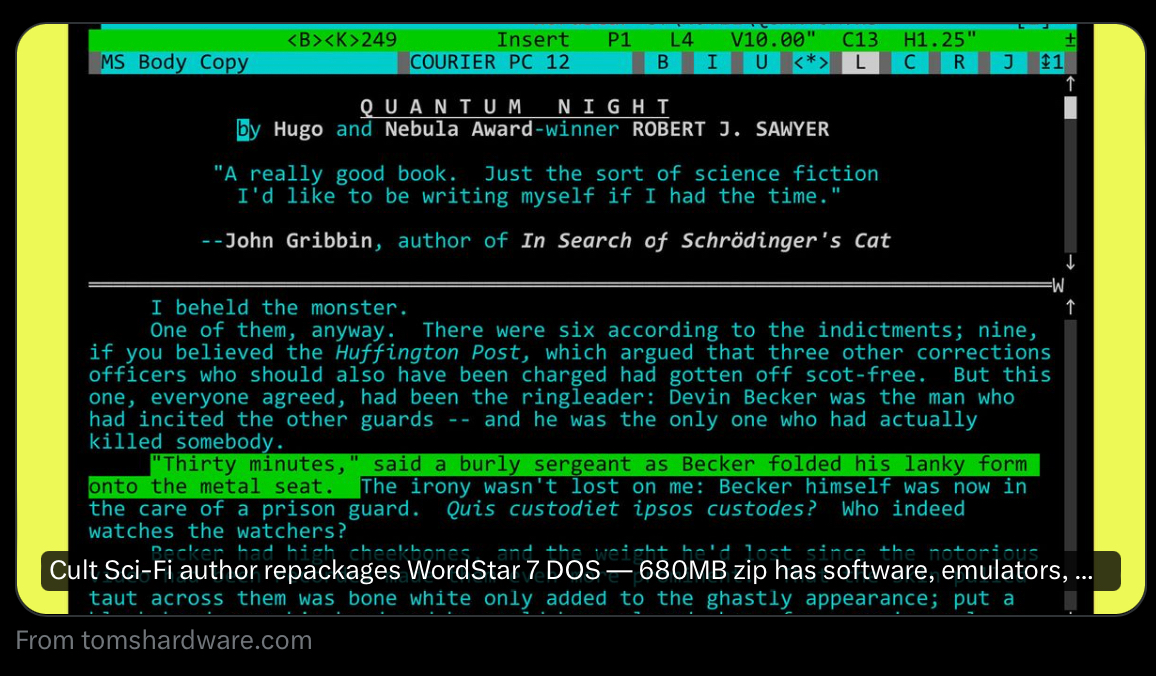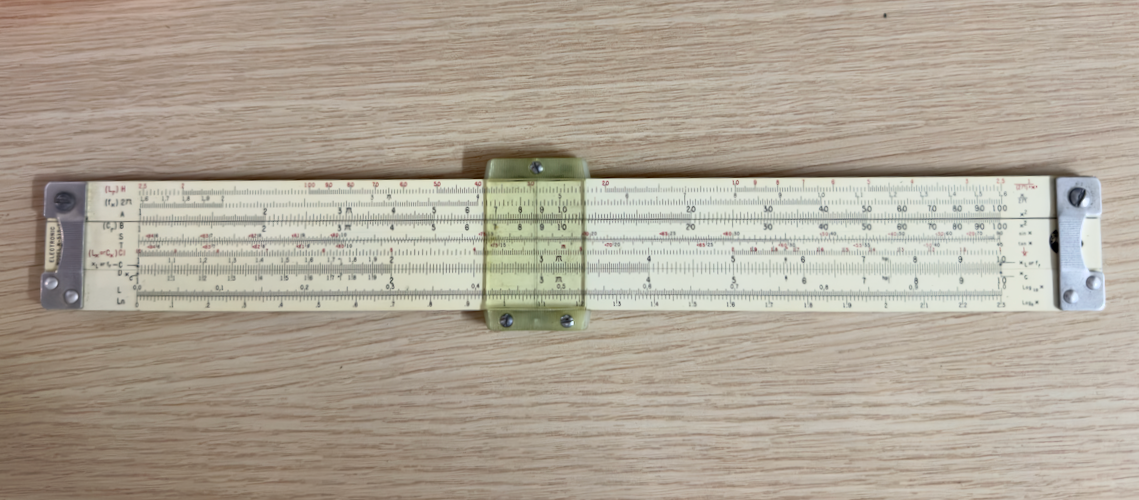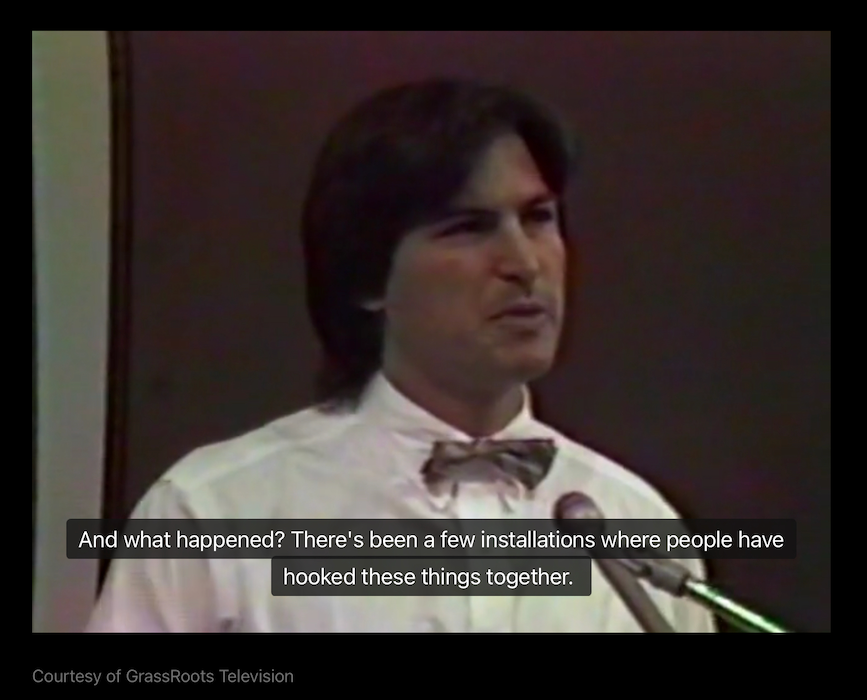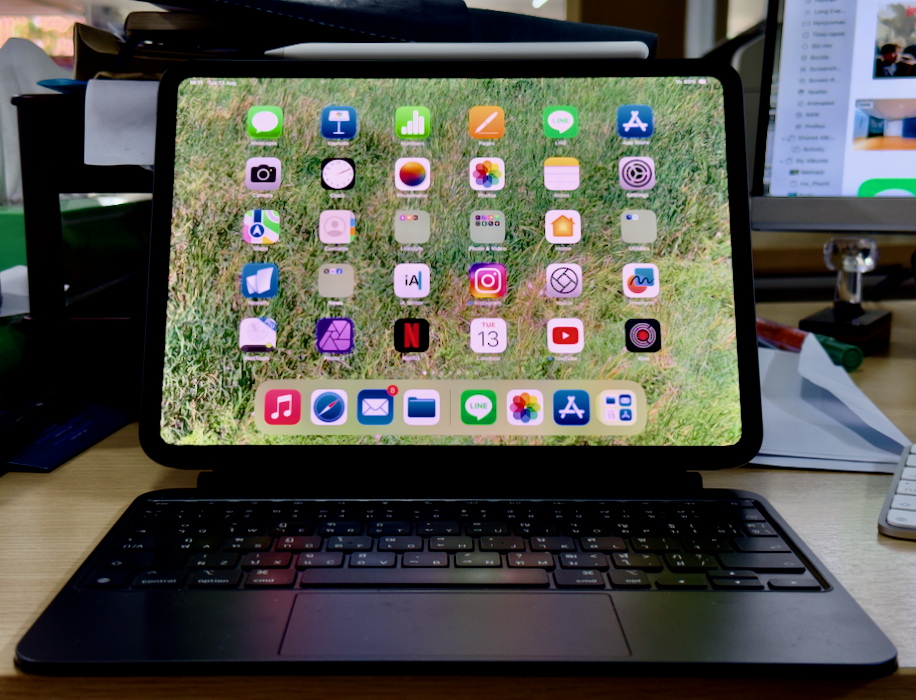
eXtensions - Tuesday 13 August 2024
By Graham K. Rogers

Old technology is in the news; and a special 1983 talk by Steve Jobs to designers. CrowdStrike is humble enough to accept the Most Epic Fail award at DefCon: a lesson for the company. Commentators are still not sure about Apple Intelligence: betas are for feedback. Pundits are still unsure about the iPad Pro and its software. It works for me and thousands of others.
I had dabbled with some early computer-like devices, and I remember the arrival of the police national computer in the UK with some pleasure (it put my stolen car arrest numbers up). Around the same time there was also a to-be-forgotten Honeywell command and control system installed by the police area I worked for that was shut down several times, including by direct order of the Chief Constable at the time, Anthony Armstrong. My first real experience of user devices, was in the USA when I taught on the English writing program of Illinois State University.
The Department decided to switch from a paper-based approach and installed a couple of hundred early PCs in several classrooms. We used Zenith machines, with twin floppy drives (no hard disk). The OS was MS-Dos 2.4 if I remember correctly, and the writing software was an early version of WordStar. The floppy-based system meant a fair amount of disk swapping (OS, program, data), but this was a wonderful learning environment: for those of us teaching; and for the students. They were initially wary of using the computers, but within a couple of weeks had dismissed their fears totally. I later taught older people to use computers and they were not so easy to deal with, looking for problems, when the students were dealing with the task.

I was reminded of this on Monday when I saw a message on X from a local user I have known for several years and who was involved in early software development here. He posted about a version of Wordstar and wrote that "A SciFi author made it possible to run it on modern PCs". The screenshot (above) linked to an article by Mark Tyson on Tom's Software, where the emulation by Robert J. Sawyer is explained in more detail and includes some history, as well as the current state of the application. That background includes a quote from Ann Rice, who said that "WordStar was "magnificent," and contrasted starkly with the "pure madness" of Microsoft Word." WordStar is not available for the Mac, but the madness of Word is. However, there is a WordTsar from SourceForge [sic] that will install on Macs (Windows and Linux), but is something of a work in progress.
I have to say that when I first moved to Macs on a Quadra, running System 6, I used Word, version 5 and that was not too bad. It has become somewhat bloated since and I tend to stick to text editors (including Notes) for most work, but do markup using BBEdit on the Mac, with the occasional foray into Pages (Mac or iPad).

While we are on old technology, when I first moved to Mahidol University I was also asked to teach writing on the International program (now MUIC). One of my students was (paradoxically) also writing for the Bangkok Post with a weekly column on Amiga. He was also working at a company that produced sophisticated (for the time) advertisements for television, as well as one of the logos for a Thai television company (Channel 7 I seem to remember).
This week I saw an item on Boing Boing Rob Beschizza about the early use of this computer system by the iconoclastic Andy Warhol. A lot of his work was on floppy disks and it was thought these were lost. Now they have been found. Also included with the article is a video of the original 1985 Amiga introduction and what it could do. Compared with the PC and even the Mac this was far more advanced. Near the end of the video, Debbie Harry (Blondie) comes on stage and is painted by Warhol using the Amiga. Despite its advanced capabilities it was not overly expensive for the time, but the company went bankrupt in 1994. You can still find the Amiga on eBay.
Continuing a historical note, on Tuesday morning in my RSS feed, I saw a note from John Gruber on Steve Jobs talk at a design conference in Aspen in 1983. Gruber's comment links directly to the Steve Jobs Archive and as well as a video of the talk at the end (a video summary at the top), there is a text outline, itself worth reading. It was written by Jony Ive. There are no slides. He just uses a notebook. I was impressed particularly with the comments,
He looked closely at kitchen appliances and VW vans, wine labels, gallery paintings, motorcycles, and telephones. He took the Macintosh team to San Francisco's de Young Museum to see an exhibit of Tiffany lamps. . . . He was developing his eye, absorbing into his bones the lesson that good design is not mere decoration or ornament, but a paring away to help an object reveal its essence and, ultimately, evoke an emotional connection with its user.

As Nicholas Negroponte wrote to me in an email when I asked him questions on his book, Being Digital, which I was reviewing, "You have to keep to the essence of things", a comment I pass on to my students.
The text that accompanies this 1983 talk is well-worth reading, but it is also worth taking time to watch the video for the succession of ideas that Jobs was discussing. Some of these technologies and solutions are with us now, but it is the sense that he has of the shape of things to come that held me. When the iPhone was announced in January 2007, the "three products" that were the iPhone were introduced separately, with the last being, "a breakthrough internet communications device" which met almost zero response. Few in the audience could appreciate how this ability would affect all of us in the coming years.
Many were critical of CrowdStrike following the major problems that followed its software update that crashed computer systems worldwide. I mellowed a little when it was revealed that EU requirements had weakened Microsoft's security and allowed agents, other than Microsoft, to gain access to the kernel level: not possible on the Mac. The CEO of Delta airlines - badly affected by the crash - was not slow in pointing this out (Daryl Baxter, iMore). Delta are girding up to sue CrowdStrike and Microsoft, but a report by Alex Scroxton in Computer Weekly suggests there will be some resistance. The CEO of CrowdStrike, George Kurtz (who was CTO of McAfee in 2009 when they released an update that crashed many Windows XP systems) was quick to admit to the problem, and apologized. The company worked with Microsoft in the days afterwards to provide solutions which soon followed.
Now, Antony Ha (TechCrunch) reports that the company president Michael Sentonas has taken another step up in my regard for how he has reacted to the event, by accepting the Most Epic Fail award at DefCon, with some good grace. The company sent a message of "gratitude and appreciation for the Black Hat community." Among other comments he is reported as saying that he would take the trophy back to CrowdStrike HQ and display it in a prominent place, as a reminder that "our goal is to protect people, and we got this wrong, and I want to make sure everybody understands these things can't happen." A lesson in humility here: something many organizations should take on board.
I made some comments last time on the early opinions concerning Apple Intelligence: a couple of days after the beta release of iOS 18.1, several in the tech press were wringing their hands. Dan Moren, however, had a more pragmatic approach. Generally, Moren is well-satisfied with the play so far, with one exception (Image Playground): "it stills seems more like a gimmick than something useful". Duly noted. Apple can fix that. I do not use beta installations these days, but commented that if Apple receives feedback from developers (and other users) those ideas are taken on board and sometimes there are changes. Apple does not simply ignore feedback. The purpose of beta testing is to find out how to improve the product.
Also in the comments last week were opinions from a number of commentators that, despite not yet being released, Apple was expected to charge for the AI features, at least some time in the future, or there may be an additional AI+ level with special features that Apple could charge for. Rajesh Pandey, Cult of Mac, reports this week that if such charges are to be included, this is not likely to happen until at least for the next 3 years, confirming some ideas that had been expressed, but also underling the point that this is not imminent.
This week, Lloyd Coombes (iMore) reports that with the upcoming release of iOS 18, Apple is expected to have removed some of the features in Photos that were announced at WWDC on the organization. Coombes specifically mentions the Carousel. I had been fairly happy with the Days . . . Years format along with Albums, so was unmoved by the WWDC announcement. I think Photos needs a complete rewrite anyway, particularly with the editing tools, and specifically for the iPad. The app used to match Photos on the Mac and that made switching between platforms fairly easy, although the toolsets on Macs and iOS were not identical. The way I edit images on the iPad is not the same as on the iPhone and when editing images I will often switch to Photomator (or other apps) or even to the Mac for specific effects that are available for black and white photography.
Several commentators have made remarks on the iPad Pro since WWDC and many feel that iPadOS is insufficient for what the device does. For me, some apps need more features, but that depends on the task. In addition, there are certain tasks that need me to switch to the Mac, such as FTP (loading files up to my site), tethering, and using a flatbed scanner. There is FTP software for the iPad (and iPhone) but I find this less easy to use than the simple processes of Fetch or Transmit. The Hasselblad app apparently does allow tethering of its cameras to the iPad, so this may not be impossible: just no suitable apps. There are apps that allow scanning with those all-in-one printer/scanner devices, but more professional scanning, such as scanning negatives, needs a flatbed or high-level rotary scanner. If I have to do one of these tasks, I switch to the Mac.

The iPad, and specifically the iPad Pro was brought up at the Talk Show Live by John Gruber in June after the WWDC announcements. I noted then that "At 58:17 Gruber brings up the iconic slide at an earlier WWDC which addressed the merging of Mac and the iPad, with the single word, No." That has not, of course, stopped several commentators (e.g Dennis Sellers, AppleWorld Today; David Price, MacWorld; et al from pushing the idea that the iPad Pro needs a more robust operating system. We already have iOS, iPadOS, macOS: does that mean they want iPadProOS; or are they after macOS for the iPadPro. Does No really mean, Yes for some people?
This week John Gruber (he of Talk Show Live), who is highly respected for his knowledge and opinions, wrote comments initially on recent changes to macOS concerning privileges (and reauthorizing screen recording applications), something that Howard Oakley has also expressed some concern about. Adam Engst (TidBits) also comments on the new way that Apple has introduced to make users affirm that the app they are trying to start is really legitimate. The process is getting in the way and users will end up ignoring the prompts, leading to reduced security. Engst also mentions a number of others who have written on this. After a long discussion on the Mac's recent, changes, which are still in beta, Gruber veers to the iPad Pro. As I note above, there are some tasks I cannot do on the iPad, so switch to the Mac.
Gruber comments that some Mac users would "prefer to be using an iPad instead of a Mac but can't, because an iPad can't do one or more things they need to do, or run software they need to run." As I have noted before, these days, we are task-oriented: the device and the app for the job to be done. Gruber himself noted back in May how he wrote on the iPad, but did markup on the Mac. The final paragraph seems to suggest a change of opinion on the iPad: "Power tools and user-safety features aren't mutually exclusive. But they need to be in balance. Apple is clearly losing that balance with MacOS, and I think a big part of that is the iPad's weaknesses tipping the scale." I agree with the first two sentences here, but the final comment has me scratching my head. Right or wrong: I don't know, but the iPad works for me on a daily basis, with one or two specific exceptions. While writing this I reread the May article by Gruber and the case for the limited nature of the iPadPro software is much better stated. I also note above that, the Photos app is far to weak for my requirements, so I am beginning to sense this argument about the iPad Pro (great hardware, limited software) has some legs to it. But not macOS. . . .
Graham K. Rogers teaches at the Faculty of Engineering, Mahidol University in Thailand. He wrote in the Bangkok Post, Database supplement on IT subjects. For the last seven years of Database he wrote a column on Apple and Macs. After 3 years writing a column in the Life supplement, he is now no longer associated with the Bangkok Post. He can be followed on X (@extensions_th). The RSS feed for the articles is http://www.extensions.in.th/ext_link.xml - copy and paste into your feed reader.

For further information, e-mail to
Back to
eXtensions
Back to
Home Page